Aug 14, 2020 | COVID19, IIASA Network, Sustainable Development
By Nebojsa Nakicenovic, Director of The World In 2050 and Emeritus Research Scholar at IIASA
IIASA Emeritus Scholar Nebojsa Nakicenovic explains how the societal disruptions caused by the coronavirus pandemic can offer an opportunity for a more sustainable and innovative future.
While the future of humanity has always been unpredictable, major challenges — like the current pandemic — have been an inevitable part of our shared history. What is different now, however, is that human beings have become the dominant force of planetary change. In other words, the Anthropocene has arrived, and with it an unprecedented opportunity to steer our collective future.
Science, technology, and innovation (STI) are the drivers of this change, and can also be the means of achieving a sustainable, equitable, and resilient future for both human civilization and the biosphere. These tools, however, need to be complemented with the necessary evolutions of our economies, public institutions, and behavioral norms. The rapid rise in inequality and resource consumption over the last few decades, for example, has led to increasing pressure on people and the planet in ways that are clearly unsustainable. It is within this context that the COVID-19 pandemic could become a disruptive event that triggers fundamental change toward a more desirable future for all.
Human history is rich with other instances of rapid social and environmental evolution, from the agricultural turn of the Neolithic Revolution some ten thousand years ago to the explosive changes brought about by the Industrial Revolution two centuries ago. However, it was the ‘great acceleration’ of the last 50 years, characterized by exponential growth of consumption and rapid degradation of planetary support systems, that brought us to the geophysical limits of our home world for the first time. These rapid developments were neither smooth nor pervasive, and were interlaced with many crises, wars and pandemics, natural disasters, and numerous other disruptive events. Yet over the last 200 years we’ve seen a 7x increase in the global population, a 100x increase in economic output, and a 20x increase in carbon dioxide emissions.

Photo by Holger Link on Unsplash
In the aftermath of major crises that caused deep disruption, loss of life, and the destruction of capital and jobs, a ‘new normal’ eventually emerged — the major depressions of the 1870s and 1930s, as well as the oil crisis of the 1970s, are just three examples among many. Events like these arguably amplified the limits and disadvantages of the ‘old’ and paved the way for the ‘new’, with each crisis catalyzing innovation and the re-direction of human activities towards a fundamentally new direction. Today, we might say that each caused a tipping point that led to new development and behavioral pathways.
The COVID-19 pandemic, one of the greatest threats to human societies in recent memory, can be seen as a similarly catalytic event. While history does not repeat itself, there are many similarities in the response strategies to earlier pandemics such as the Black Plague of the middle ages and the Spanish Flu of the 1920s, including policies of ‘social distancing’ and isolation and barriers of entry to those from ‘outside’. Even the word quarantine (meaning ‘forty days’ in Venetian) was first coined during the plague epidemic of the 14th century.

Photo by Cheng Feng on Unsplash
Today’s crisis, as in the past, has revealed the worst parts of our nature, as with the callous exclusion of the needy, homeless, and migrants from the emerging responses, as well as the hoarding of perceived scarce goods by the well-off. At the same time, the pandemic has brought out some of the best human characteristics: self-sacrifice in helping others, renewed empathy and solidarity, and unprecedented global cooperation within science and between governments as we work to stem the worst of the pandemic.
Moreover, there is mounting evidence that the partial shut-down of the global economy has had demonstrably positive effects on the environment, such as reduced emission levels, lower pollution, and a resurgence in wildlife. While an economic depression is by no means a viable mitigation strategy for climate change and other pressing environmental issues, these data make clear that the right policies and priority investments in STI could have immediate and significant effects in our efforts to transition to a sustainable world.
Many scientists, policymakers, and other stakeholders are already working to leverage this current moment of opportunity into lasting change. The World in 2050, a global research agenda aiming to help reach the United Nations’ Sustainable Development Goals, offers six transformations that outline essential STI, institutional, and behavioral synergies to achieve the new direction for human development while providing critical support for the most vulnerable among us. The Earth Commission, a group of leading scientists convened by Future Earth, is working to underpin the development of science-based targets for systems like land, water, and biodiversity in order to guide companies and cities towards sustainable pathways, as many thought leaders are beginning to reconsider the stability and efficiency of our current economic systems. Thomas Piketty, for example, has recently proposed that every person should receive $120,000 at age of 25 to enable innovative initiatives among those who lack the capital to do so. Bold efforts like these will become increasingly necessary as we work towards a new set of planetary operating parameters that will ensure an equitable and sustainable future for all.
Our response to COVID-19 could help redirect trillions of dollars towards this agenda. While current measures aim to preserve existing institutional and economic arrangements, we should press decision makers to actively channel these funds into the drivers of innovation to bring about the future we want to live in. This deep and ongoing crisis may destroy some of the ‘old’ characteristics of this moment in human history, and could bring about the transformations in sustainability that will enable us to build a better future for all life here on Earth. The risk is that exactly the opposite will happen — and that is a risk that humanity cannot afford to take.
This piece was originally published on Medium and Future Earth.
Note: This article gives the views of the author, and not the position of the Nexus blog, nor of the International Institute for Applied Systems Analysis.
Jun 5, 2020 | COVID19, Demography, Health, IIASA Network
By Tomas Sobotka, Wittgenstein Centre for Demography and Global Human Capital (Univ. Vienna, IIASA, VID/ÖAW), Vienna Institute of Demography
Does COVID-19 affect men and women differently? Tomas Sobotka sheds light on the demographics of the coronavirus pandemic in Europe.
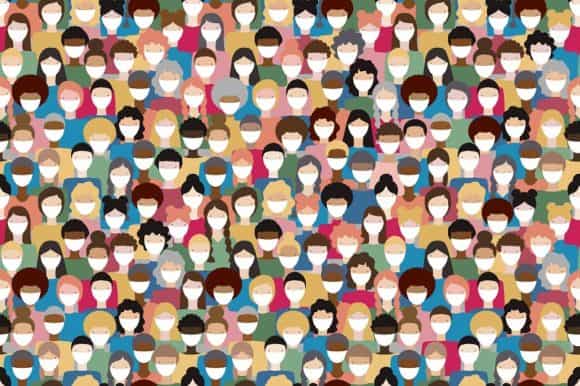
© Florin Seitan | Dreamstime.com
A question from a Time magazine article has a clear underlying message: “Why is COVID-19 striking men harder than women?” By now, everyone has learned that men are more vulnerable to COVID-19 and, if infected, they tend to die much more often than women.
Are men however also more likely to get infected? On the face of it, the number of infections by gender suggests an almost perfect gender equality. Women represent on average 47% of all infections in 70 countries reporting the number of cases by sex, as listed in the online data tracker by Global Health 5050.
Case settled? Not quite yet. The aggregated total number might be deceiving. To understand an underlying story, one has to dig into the age and sex components of total infections. The overall balance of COVID cases by gender is an outcome of age- and sex-specific patterns of infection rates and the actual age- and sex composition of the population. This in turn, is often gender-unequal, especially at older ages, due to excess mortality among men and higher longevity of women.
In fact, in ten European countries I examined with colleagues from the Wittgenstein Centre for Demography and Global Human Capital, including Raya Muttarak from the IIASA World Population Program, it turns out that infection rates are highly gendered, especially when looking at the age pattern of coronavirus infection. From the teenage years up until their late 50s, women are more likely than men to be infected with COVID-19. Women in their 20s display the biggest gender gap in infections: on average only 64 men were infected per 100 infected women aged 20-29. After age 60, the pattern reverses, as infection rates among women drop at age 60-69 and the male infection rates go up or stay stable. This crossover is also clearly visible in the charts for Belgium, Czechia, Germany, and Italy. Between ages 60 and 79, men are more likely than women to be infected. The imbalance is sharpest among people in their 70s, with an average of 136 infected males per 100 infected women. This puts older males at a double disadvantage: they are more likely to be infected and, once infected, they are much more likely to die (with both higher age and being a male identified as important risk factors).
Is our evidence credible? Clearly, many infections are undetected and our data are affected by different testing availability and testing priorities across countries. It is possible that women of working age get more frequently tested than men as women tend to be more concerned about their health. This would bias the estimated share of infected women upwards. However, the remarkable regularity in the age- and gender-pattern of infections in the analyzed countries suggests that the observed gender disparities are real. The same gender disparity by age is observed in Czechia, Denmark, Germany, and Norway with relatively few infections, as well as in Belgium, England, Italy, and Spain with high numbers of reported infections. Of course, countries differ in their gender imbalance, especially at younger ages: the gender gap is, well, gaping, in Belgium, which reports only 34 infected men per 100 infected women at age 20-29. It is much smaller in Czechia, Germany, and Norway, but the female dominance at young ages and the male dominance at older ages, with a crossover around age 60, is consistently found in each society we studied.
What’s the likely explanation? At younger ages, the smoking gun points at women’s employment and occupations. Most women of working age in Europe are employed. This may also partly explain why European countries actually register a higher number of infections among women than most other countries, with an average share of 55%. More importantly, women are often working in professions that are most exposed to the infection. Think of nurses, medical doctors, other healthcare professionals, but also all the care workers in retirement homes, which turned out in some countries to be the focal points of infection. The switch in gender balance occurs right around the retirement age. The higher likelihood of infection among older men is probably linked with their poorer health and lower immunity.
If employment is potentially risky for women, staying at home with children—itself a product of ingrained gender inequalities in work and care—may lead to fewer infections. In countries where women’s employment dips after age 30 due to their extensive parental leaves, infection rates often show a distinct dip after that age as well, going up again in their 40s: Czechia, Germany, and partly Norway and Switzerland show such an M-shaped pattern of infection rates among women.
Even though the fatality rates of women below age 60 are low, engagement in care-work poses a higher risk to healthcare workers and care-home staff. This factor should be included in the ongoing discussions on the impact of COVID-19 on women’s health and wellbeing.

COVID-19 infection rates by age and sex per 1,000 population (solid line for females, dashed line for males, left-hand axis) and the relative M/F ratio in infection rates by age in four European countries
This blogpost is based on the following paper:
Sobotka T, Brzozowska Z, Muttarak R, Zeman K, & di Lego V (2020). Age, gender and COVID-19 infections. medRxiv 2020.05.24.20111765. DOI: https://doi.org/10.1101/2020.05.24.20111765
References
Global Health 5050. COVID-19 sex-disaggregated data tracker. https://globalhealth5050.org/covid19/ (accessed May 18, 2020)
Ducharme J. Why Is COVID-19 Striking Men Harder Than Women? Time, 1 May 2020. https://time.com/5829202/covid-19-gender-differences/
Note: This article gives the views of the author, and not the position of the Nexus blog, nor of the International Institute for Applied Systems Analysis.
Apr 17, 2020 | Alumni, Germany, IIASA Network, Systems Analysis
By Liza Soutschek, doctoral researcher at the Leibniz Institute for Contemporary History, Germany
Liza Soutschek shares her journey in researching the institute’s history relating to the Cold War for her PhD dissertation.
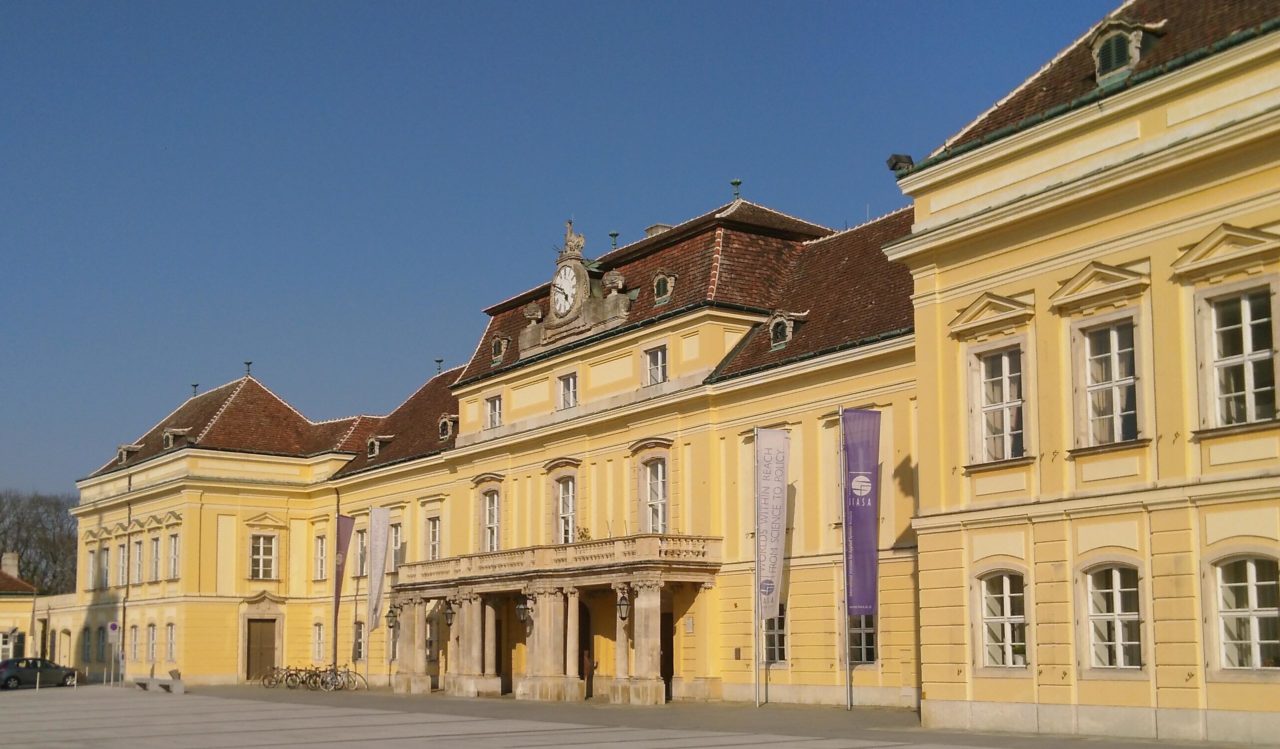
© Liza Soutschek
IIASA, Schloss Laxenburg, November 1975
Howard Raiffa, the founding director of IIASA, was about to leave Schloss Laxenburg in November 1975 to return to the USA. In his farewell address, he reflected on the institute’s first three years as an East-West research institute during the Cold War and concluded:
“My most exhilarating moments at IIASA, the times when I feel most rewarded by all our efforts, occur whenever I am present at a scientific meeting and scientists from different disciplines and cultural backgrounds argue with each other, on substantive issues, without being conscious of their roles as mathematicians or economists or management scientists or of their national identities. I will never forget those times, when [Wolf] Haefele of F.R.G. [West Germany] and [Hans] Knop of G.D.R. [East Germany] would argue heatedly on a scientific point – sometimes on the same side and at other times on opposite sides.”
As Howard Raiffa pointed out, IIASA, founded in 1972 in the wake of Cold War détente, provided an exceptional platform for scientific dialogue and exchange across borders – in particular for East and West Germans.
Intrigued by IIASA’s history
Looking back from the present day, knowing how difficult interdisciplinary collaboration between scientists from different nations and cultures can be, one question that comes up right away is: what was it like working at IIASA in the 1970s and 1980s in the context of the Cold War?
I asked myself this question when I first came across IIASA in the fall of 2017, and the spring of 2018, when I started working on a dissertation project on the institute’s East and West German history. It is done as part of a research group that examined “Cooperation and Competition in the Sciences” in case studies from a historical perspective. In my dissertation, I analyzed the relations between scientific and political actors from East and West Germany in the context of IIASA, with a focus on mechanisms of collaboration and competition at the local site as well as on wider effects in the entangled Cold War German history.
Historical research: books, dust, and coffee
Historians write books, but in order to do that we have to read hundreds of other books, look for traces in (sometimes more, sometimes less) dusty archives, and drink a lot of coffee with interesting people.
Initially my research led me to several German state and scientific archives. In the Federal Archives, for example, I found evidence of close interconnections between German science and politics during the Cold War regarding IIASA – not only in the case of the GDR, but also the FRG. Besides the intention to build a bridge between East and West, IIASA was also an arena for Cold War rivalry in the eyes of both German states. My favorite archival find were the documents of the Max Plank Society, which was the former West German National Member Organization of IIASA.
In Germany, I also had the opportunity to talk to former West German members of the IIASA energy group in the 1970s and 1980s. Among them was Rudolf Avenhaus, who started working in the energy project under the leadership of Wolf Häfele in the summer of 1973. Over several cups of coffee, he told me about his life, what it was like to work at IIASA in those years, and about his collaboration with Willi Hätscher, one of the few East Germans in the group at that time.
A visit to IIASA and an inquiry
I finally had the chance to visit IIASA in the summer of 2019. With the help of several IIASA colleagues, I explored the IIASA archive for insights into the institute’s East-West German history. I also had the opportunity to discover more by talking to former and current IIASA employees. Two conversations I want to mention in particular, were with long-term staff members Martha Wohlwendt and Ruth Steiner, who provided an alternative view of IIASA to that of the scientists. I enjoyed my visit to the beautiful Schloss Laxenburg immensely and hope to return.
After collecting all these sources, from archival records to personal interviews, I can now begin writing an account on how cooperation and competition formed the relations between East and West Germans in the context of IIASA and thus, make IIASA’s history even better known.
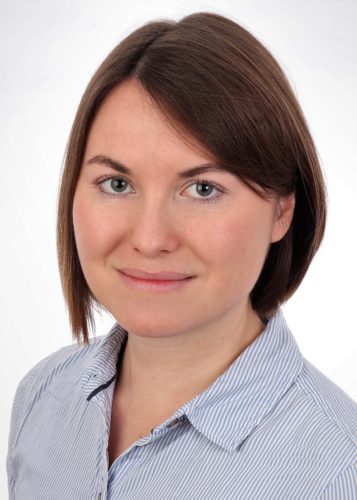
© Liza Soutschek
After sharing this insight into my research, I would like to end with an inquiry. If you read this and think, “I could add something to this story!”, I would be happy to hear from you. Whether you are a former German IIASA staff member or have another connection to all of this, maybe we can add another piece to the puzzle together.
Contact:
Liza Soutschek
Institut für Zeitgeschichte München – Berlin
Leonrodstr. 46b, 80636 München, Germany
soutschek@ifz-muenchen.de
Note: This article gives the views of the author, and not the position of the Nexus blog, nor of the International Institute for Applied Systems Analysis.
More on the history of IIASA.
Mar 10, 2020 | COVID19, Health, IIASA Network, Wellbeing, Women in Science
Raya Muttarak, Deputy Program Director, IIASA World Population Program
Raya Muttarak writes about what we have learnt about the COVID-19 outbreak so far, and how collective mitigation measures could influence the spread of the disease.
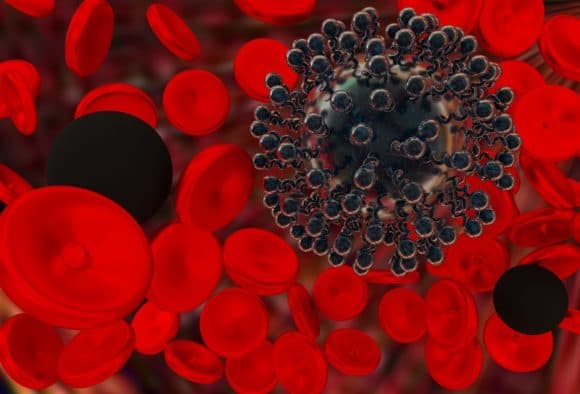
© Konstantinos A | Dreamstime.com
Since the outbreak of COVID-19 in Wuhan, China back in January, we have learnt a lot about the virus: we know how to detect the symptoms, and a vaccination is currently being developed. However, there are still many uncertainties:
We for example don’t know enough about the disease’s fatality rate – mainly because we don’t precisely know how many people are infected, which is the denominator. We also don’t know exactly how the virus spreads. Generally, it is assumed that the virus spreads from person-to-person through close contact (within about 1 meter) and through respiratory droplets produced when an infected person coughs or sneezes. It is also thought that COVID-19 can spread from contact with contaminated surfaces or objects.
In addition, knowledge about the timing of infectiousness is still uncertain. There is evidence that the transmission can happen before the onset of symptoms, although it is commonly thought that people are most contagious when they are most symptomatic. This information is crucial, because if we know the timing patterns of the transmission, we could adopt better measures around when to quarantine an infected person.
Lastly, we don’t yet know whether the spread of the disease will slow down once the weather gets warmer.
What is currently happening in Iran, Italy, Japan, and South Korea may be unique to these countries, but it is more than likely that most countries will eventually experience the spread of COVID-19. In this regard, epidemiologists have estimated that in the absence of mitigation measures, in the worst-case scenario, approximately 60% of the population would become infected. In February, Nancy Messonnier, the director of the Centers for Disease Control and Prevention’s National Centre for Immunization and Respiratory Diseases in the US, warned that “It’s not so much of a question of if this will happen anymore, but rather more of a question of exactly when this will happen.”
We learnt from an epidemiological transmission model that public efforts to curb the transmission of the disease should be directed towards flattening the epidemic curve. This is crucial, since the treatment of severe lung failure caused by COVID-19 requires ventilators to help patients breathe in intensive care units (ICUs). Not a single country in the world has the capacity to absorb the large number of people who would need intensive care at the same time. Experience from Italy shows that about 10% of all patients who test positive for COVID-19 require intensive care. Although efforts have been made to increase ICU capacity, the rapidly growing number of infected patients is overloading the healthcare system. Measures to reduce transmission in order to slow down the epidemic over the course of the year will therefore significantly mitigate the impact of COVID-19.

A transmission model with and without intervention.
Source: CDC. (2007). Interim Pre-pandemic Planning Guidance: Community Strategy for Pandemic Influenza Mitigation in the United States—. Centers for Disease Control and Prevention.
The figure above shows the distribution of infectious cases with and without intervention. If the outbreak peak can be delayed, this allows the health system and healthcare professionals to bring the number of persons that require hospitalization and intensive care in line with the nation’s capacity to provide medical care. To flatten the epidemic curve and lower peak morbidity and mortality, calls for both government response and individual actions.
We will have to follow the protocol of the Austrian Health Ministry, but certain practices such as social distancing, washing hands, and avoiding gathering in crowded places, can help reduce the transmission of the disease. While it is true that young and healthy people are less likely to get sick and die from COVID-19, they can still be a virus carrier and thus transmit the disease to other vulnerable subgroups of the population, such as older people and those with underlying health conditions. An article recently published in The Lancet provides helpful information to better understand the current situation and explains why fighting against COVID-19 will take collective action.
Reference:
Anderson R, Heesterbeek H, Klinkenberg D, & Hollingsworth T (2020). How will country-based mitigation measures influence the course of the COVID-19 epidemic? The Lancet 0(0) DOI: 10.1016/S0140-6736(20)30567-5
Note: This article gives the views of the author, and not the position of the Nexus blog, nor of the International Institute for Applied Systems Analysis.
Jan 9, 2020 | Ecosystems, IIASA Network, Postdoc
By: Florian Hofhansl, postdoc in the IIASA Ecosystems Services and Management and Evolution and Ecology Programs
Florian Hofhansl shares his experience on presenting the wildfire climate impacts and adaptation model (FLAM) at the Google Exhibition Booth at the 2019 American Geosciences Union meeting held in San Francisco 9-13 December.
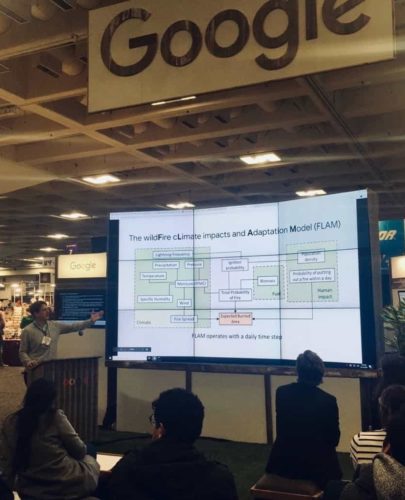
© Florian Hofhansl | Florian presenting the wildfire climate impacts and adaptation model (FLAM) at the Google Exhibit Booth.
The American Geosciences Union (AGU) Fall Meeting is the largest international Earth and space science meeting in the world. AGU is a great place to reconnect with colleagues as well as to build-up new professional relationships. The 2019 conference marked its Centennial in San Francisco, the home of the AGU Fall Meeting for more than 40 years, and thus I gladly took the offer to give a presentation about FLAM at the Google Exhibit Booth.
It was an honor to represent IIASA by presenting FLAM and discussing its implementation on the Google Earth Engine platform with experts face-to-face on-site. Right after the presentation I ran into a former YSSPer Sarath Guttikunda, who indicated that his experience in the IIASA Young Scientists Summer Program (YSSP) had a profound influence on his professional and personal life.
Another highlight of this year’s centennial conference edition was a presentation by Cesar Terrer, winner of the Peccei Award with Honors from the 2016 YSSP, who was invited to present a young scientists view of the future. His talk entitled “The future of earth vegetation under rising CO2” was featured in a special lighting talk session.
I have been attending the Fall Meeting since 2012 and will continue to attend this meeting for the foreseeable future as it is a great place to network with colleagues and embrace the joy of science with the community. Over the years, I keep on being inspired by other researchers filled with new perspectives, and have participated in scientific discussions that we hope will make our planet more sustainable.
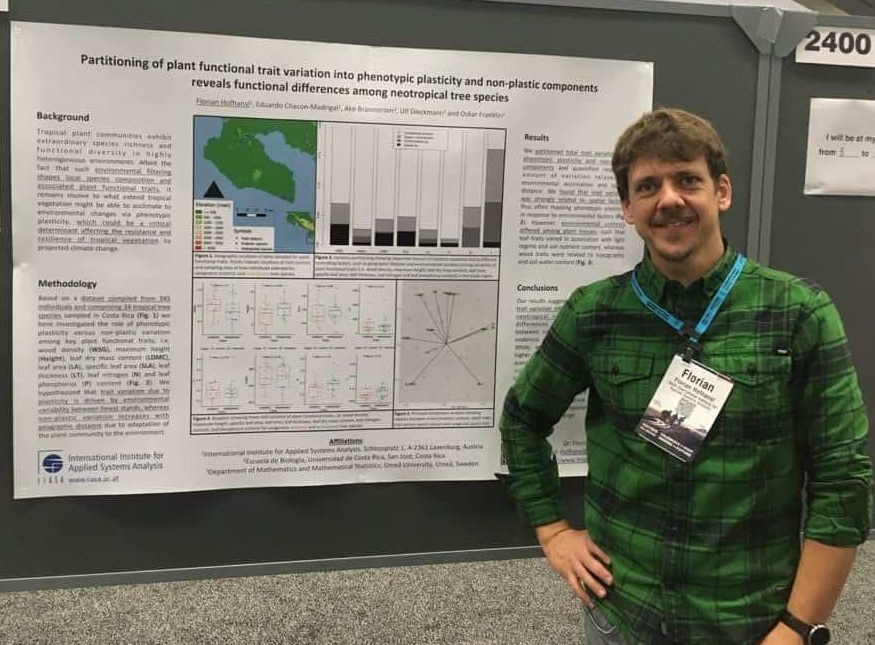
© Florian Hofhansl | Florian presenting a poster about tropical plant functional traits at AGU19.
More about Florian Hofhansl’s research can be found here: https://tropicalbio.me/blog/.
Note: This article gives the views of the author, and not the position of the Nexus blog, nor of the International Institute for Applied Systems Analysis.
Dec 10, 2019 | Alumni, IIASA Network, Women in Science
By Luiza Toledo, Science Communication Fellow 2019
Luiza Toledo writes about how the IIASA Women in Science Club are creating a safe space to talk about and advance gender equality in science.
Sustainable Development Goal (SDG) 5 is to achieve gender equality and empower all women and girls. A recent report titled, Harnessing the power of data for gender equality produced by Equal Measures 2030, however, shows that we still have a long way to go before this goal becomes a reality.
Countries in Europe and North America, along with two in the Asia-Pacific region (Australia and New Zealand), achieved the highest scores in terms of gender equality on the 2019 SDG Gender Index. However, even in the 20 top scoring countries, there are still indicators that score low. This suggests that even the countries with high overall scores for gender equality are struggling with thorny issues – one of them being women in science and technology research positions.
As an international institute, IIASA was founded on the principles of equal opportunity, which naturally includes equality in terms of gender balance. The institute’s 2018 Annual Report shows that the number of early-career female IIASA scientists has steadily been growing over the last few years. Since 2016, the number of female researchers increased by 24%, with most of the new hires joining as research assistants. Despite this increasing trend, the gap for PhD level researchers is as high as it has ever been with men outnumbering women four to one. In addition, there is a lack of female scientists in the over-40 age group, which is by no means unique to IIASA. Researchers who study gender and science have even compared women’s careers in science with a leaky pipeline – a flawed channel system that loses quantity before it reaches the destination.
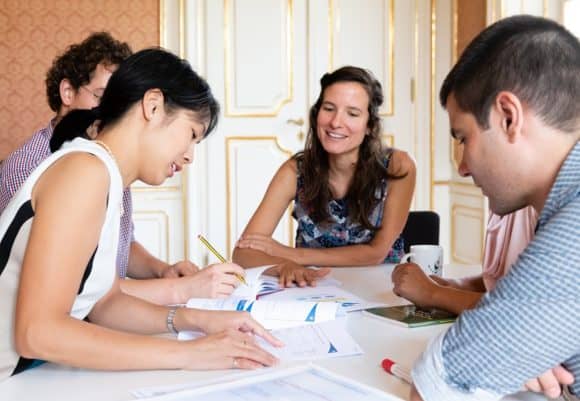
©Liebentritt_Christoph
Even though it is unrealistic to expect a 100% retention of women in science related careers (or any career for that matter), male researchers still have a much higher retention rate in scientific careers than their female colleagues do, and this is where the problem lies. According to the IIASA Diversity and Work Environment Report from 2015, male researchers at IIASA on average stay with the institute for seven years, whereas female researchers stay for only four years. To overcome the leaky pipeline effect, we should start creating a workplace culture that aims to recruit and retain women and is more open to discussing and tackling gender issues in academia, thereby developing a safe networking space.
The Women in Science Club (WISC) at IIASA is a great example of a safe networking space that embraces gender equality and shows the power of women that support other women. Co-led led by Amanda Palazzo, a researcher in the institute’s Ecosystems Services and Management Program, and IIASA Network and Alumni Officer Monika Bauer, the club has a self-proclaimed mission to build a network where women connected to science can share experiences, empower themselves, and highlight the work of other women connected to science.
The idea of creating a network of women in science came about in the fall of 2016 when former Finnish President, Tarja Halonen, visited IIASA. During her visit, she asked to meet with the women of IIASA to talk about diversity and equity issues. This conversation was the first of several meetings that are now attended by women (and men) across the institute under the auspices of WISC.
“The conversation was inspiring and after that first meeting, a few of us thought about organizing a club to continue working on the issues that came up from our discussion with President Halonen,” explains Palazzo.
Nowadays, the WISC organizers arrange lunchtime meetings known as “Meet, greet, and eat” sessions to coincide with visits to IIASA by prominent researchers and other professionals from IIASA and elsewhere who want to share their experiences.
“I’ve found that more experienced and senior women who may have been the only women in their departments at the start of their careers or may have had to fight for a seat at the table are often the quickest to agree to meet with WISC. This shows me that they see the value in a club like ours,” Palazzo adds.
Although the number of women now engaged in science is the highest it has ever been, there are still too few women in positions of leadership. According to Palazzo, at IIASA, this situation is set to change with the institute’s newly appointed Deputy Director General for Science who joined IIASA in November this year.
“I’m excited that Leena Srivastava has joined us and I hope that this is just the start of many changes at IIASA that will bring more women into positions of leadership,” she says.
Palazzo says that the most valuable thing that she has learned so far is that no two women have the same story or path to success.
“I found it reassuring to hear successful women tell us that when they were starting out or even several years into their careers they also didn’t know exactly what contribution they wanted to make. They were learning as they went along. It has also been useful to hear women talk about building resilience to negative comments or behaviors and recognize that these behaviors reflect the other person’s fear and insecurity. In the end, the Women in Science Club is a place to share, contribute, listen, and learn. We want women connected to science to feel that they are a member of our community, that they have a seat at our table, and that they belong here,” she concludes.
Note: This article gives the views of the author, and not the position of the Nexus blog, nor of the International Institute for Applied Systems Analysis.












You must be logged in to post a comment.